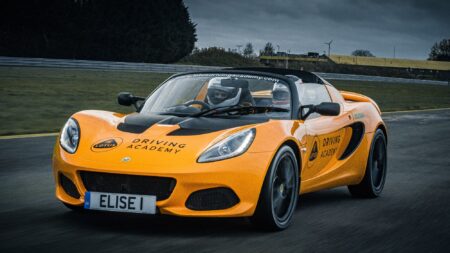
Baby Ferrari and Aston Martin classics set to go racing in 2023
The Little Car Company is set to launch a new racing series featuring scaled-down Ferrari Testa Rossas, Aston Martin DB5s and Bugatti Baby IIs
Does the new turbocharged, autoboxed Aston Martin Vantage have heart? Andrew Frankel heads to Portimão to find out
Aston Martin has made some shocking cars in its time as anyone capable of an honest assessment of the original Virage Volante will tell you but none, at least in my experience, to which the ‘Vantage’ moniker has been appended.
Of course these days a Vantage is an entire model line rather than a modified version of a pre-existing car, but the word still has the magic touch. Few cars were ever transformed as effectively as was the V8 Saloon when given the Vantage treatment in the 1970s, though you might argue the Virage coupe was one of them. As for the Vantage that has just bowed out after a dozen years of introducing Aston Martin to a new audience on the road and providing the most success on track since the marque’s ‘50s competition heyday, it was a car I adored. Even when it wasn’t very good anymore – and the truth is it was never as good as the equivalent Porsche 911 even when new – it never failed to charm me. If I were a rich man with a valuable toy cupboard, a manual V12 Vantage would be in there for sure.
The all-new Vantage is nothing like so pretty but, then again, nor was it intended to be. There is a feeling at Aston Martin that too much ‘Russian Doll’ design has been allowed of late resulting in cars of different sizes but very similar in appearance. No longer. If you want to drive a beautiful Aston, get a DB11. If you want one with enough presence to evacuate entire lanes on the motorway, the pugnacious new Vantage is for you.
Or so it seems. Dig a little deeper and you’ll discover that this apparently tough guy Vantage is not just a little bigger than the last, but heavier too. Its engine is no longer a howling naturally aspirated V8, but a turbocharged unit bought in from Mercedes-Benz. And where there were once three pedals or at least a robotised manual shift, now there is just a conventional automatic gearbox. So is the true purpose of those looks actually to create the mere perception of a street-fighting Aston because the reality is somewhat soft-bottomed?
Well you’d be forgiven for thinking that, right up until the moment you hear the thunder of its exhausts, experience the thrust of those turbos and feel the nose bit hard into the apex of the first corner at which it’s aimed. Aston Martins are now signed off by the man who’s developed every new Lotus since the Elise over 20 years ago and, believe me, it shows.
The point that needs remembering, indeed the one of which I kept having to remind myself as it slithered and drifted its way around the superb Portimão circuit, is that this is just where the new Vantage starts. Want more power? It’s hard to imagine why you might but, even so, it will get it in time. Crave manual gears? They’ll be available before the end of the year. Aston is cagey about the idea of fitting the DB11’s twin-turbo 5.2-litre V12 under the bonnet – which is known to be good for over 700bhp – but the truth is that with a little jiggery-pokery, it will fit.
For now, though, the best way to look at the new Vantage is to regard it as the old one might have been if designed with the benefit of hindsight. Certain compromises have been made in steering feel and aural excitement in the hope that this is more than made up by the car’s wildly better performance and even more forgiving manners on the limit. Likewise, while some might lament the fact that too much of the interior fittings have clearly been scavenged from the Mercedes-Benz parts bin, rather more are likely to rejoice in the fact that for the first time this century, here is an Aston Martin that’s as easy to use at its stunning to look at and wondrous to drive.
In short it’s a car I really liked though, in truth, I’d be almost certain to like a manual one with a bit more power even more. I believe there is not long to wait.
When the history of Aston Martin is written, people will look back and name the DB11 as the car that started the most recent and, so far, most profitable chapter of this most enigmatic of brands. And they will be both right and wrong so to do. Right, because the DB11 marked the starting point of what is known as ‘the second-century plan’ that has already turned around the long-term loss-making history of the company, wrong because it was at least conceived and underway before the current administration, led by Dr Andy Palmer, arrived in Gaydon. So the first new Aston to be delivered in its entirety on his watch is the car you’re looking at, the new Vantage. Palmer describes it as ‘the most exciting car I’ve launched in my 34 years in the business’.
It is, of course, derived from many of the same modules that make up the DB11, but when Matt Becker – the former Lotus chassis guru now responsible for determining the way every Aston drives – was recruited, not a single functioning Vantage existed. So this is an Aston that is exactly as its creators intended it to be, for the first time.
Longer in wheelbase, softer of spring and heavier too, with a turbocharged 4-litre engine and a conventional autobox in place of the previous Vantage’s snarling normally aspirated 4.7-litre motor and its robotised manual gearshift, you might think this a gentler, more touring-oriented Vantage. Not so say Becker and Palmer: despite the evidence to the contrary, this is a hardcore driving machine and far more sporting relative to the DB11 than was the old Vantage to the DB9.
To prove their point we’ve been brought to the wondrous Portimão circuit in the Algarve where not only is the track available but also as punishing a road route as I’ve ever punted a 500bhp sports car along.
Make that 503bhp, from its Mercedes-sourced V8. Don’t lament the lack of an Aston Martin engine in here – truth is Aston hasn’t sat down to design an engine of its own from scratch in over half a century so let’s park that thought and move on. The Vantage weighs around 1630kg, perhaps 20kg more than the last, which isn’t much give it is a physically bigger car with twin turbos at one end and a big ZF autobox at the other. It also has an electronic differential with the ability to go from fully open to fully locked-in the blink of an eye, and that weighs a bit too.
The interior is plush but perhaps less so than you’d expect of a car costing £120,900, some £25,000 more than the car it replaces. Yes, its Mercedes architecture means it all works seamlessly and intuitively enough, which is an enormous step forward over the old car whose operating system I’ve been tempted to throw a brick at in the past, but there is too much recognisably parts-bin stuff in here, as there is in the DB11. It’s spacious though, wildly more so than the old Vantage and to those of six feet in height or more, that’s going to be important.
Usually I’d prefer to familiarise myself with a new sports car on the road before trying to fling it around any track let alone one as tricky and technical as Portimão, but today that is not an option.
Literally three minutes after pressing the throttle for the very first time – the amount of time it takes to do a slow out lap, I’m driving it as fast as I am able. The engine may not snarl anymore but, my goodness, it thunders. Aston has to take the motor off the AMG peg, but it can tune the exhausts itself and the engine sounds as wonderful as you could hope given it must breathe through turbochargers. And it makes the car feel fast too, faster by far than the old car, not just because it has an extra 73bhp, but mainly because it develops more torque at less than 2000rpm than its predecessor did at its 5000rpm peak. Given that this is the starting point for the Vantage and later models will have more power still, it’s very promising.
The autobox works reasonably on the circuit, though is a little slow on the downshifts: track jockeys will definitely want the manual version Aston will announce later this year. But the stand out feature is the chassis that offers exactly the right blend of involvement and stability. Outstanding grip is summoned from its Pirelli tyres despite that they are standard Zeros (albeit ones developed specifically for this car) and not the track-oriented Corsa or Trofeo R versions, while the car’s inherent balance and electronics keep it admirably neutral and accurate all around the lap.
Turn everything off and, unsurprisingly, it will slide freely at both ends. There’s a little too much high-speed understeer for my liking, perhaps because it develops significant rear downforce at speed but still has a touch of front-end lift, but you’ll need a circuit as devilish as Portimão to find it. For those who just want to skid about, few cars with this much grip were ever also this easy to drift.
Out on the road comparisons with the similarly priced, slightly heavier, but more powerful Porsche 911 Turbos are hard to avoid. Drive the Porsche hard for an hour or two and it will leave you dumbfounded with its point-to-point pace, and the Vantage never quite manages that. The Aston is quite a bit wider and much longer in the wheelbase so it is less easy the thread down the road and less eager to angle into the apex and, with its engine up front and only two driven wheels, it’s traction is merely good rather than other-worldly. On the flipside it has a more intimate chassis feel, more communicative steering and provides its driver with more options just because you can overwhelm the grip in a way that’s rarely possible in the 911. The Porsche is faster, the Aston funnier: you take your pick.
It’s important to understand what Aston Martin has created here. There will be those who’ll tell you that for whatever it’s gained in performance and practicality, the turbos, automatic gears and too-obviously Mercedes-influenced interior of the new Vantage mean it cannot have the character of the old. It is not a view I dismiss. It doesn’t have the same charm as its predecessor. But, to me, it’s just different, not degraded. The noise is just as good, the performance, grip and on-limit behaviour far better. It is a more indulgent, more easily exploited and to my mind, therefore, a better driving machine. And you can fit into it and operate it as easily as a Mercedes-Benz, which for those who will use their Vantages every day is probably the best news of all.
The new Vantage is not perfect, but what Aston ever was? But its appeal to the heart is undiminished while its proposition to the head has been transformed.
Enough to justify such an ambitious hike in its list price? And then some.
Aston Martin Vantage specifications
Price: £120,900
Engine: 4.0-litres, 8 cylinders, turbocharged
Power: 503bhp @ 6000 rpm
Torque: 505lb ft @ 2000 rpm
Weight: 1630kg
Power to weight: 309bhp per tonne
Transmission: eight-speed auto, rear-wheel drive
0-62mph: 3.6sec
Top speed: 195mph
Economy: 20.5mpg
CO2: 245g/km

The Little Car Company is set to launch a new racing series featuring scaled-down Ferrari Testa Rossas, Aston Martin DB5s and Bugatti Baby IIs

Sponsored by e-visa.co.uk Many motorcyclists head to Canada for an adventure on their two-wheeler. And with good reason. The country has a lot to offer motorcyclists, including unrivalled and diverse…

The last time that the Mercedes W10 ran in front of a crowd at Silverstone, it was carrying Lewis Hamilton to victory in the 2019 British Grand Prix. Last night…

The shops are shut, it’s too late for delivery, and Santa won't wait for any last-minute shopper. If you’re buying for a racing fan, then it’s beginning to look a…